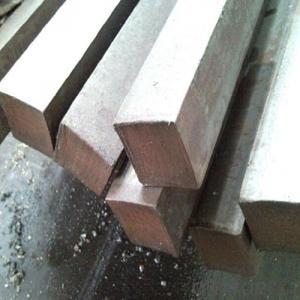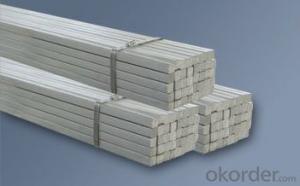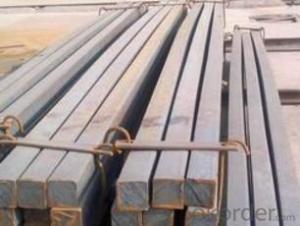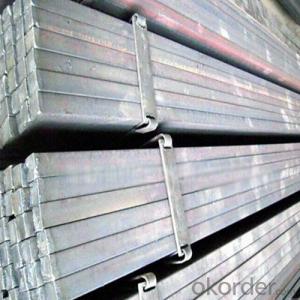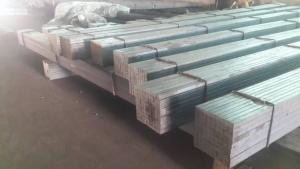Steel Billet in Square Straight Form Big Sizes
- Loading Port:
- Tianjin
- Payment Terms:
- TT OR LC
- Min Order Qty:
- 25 m.t.
- Supply Capability:
- 1000 m.t./month
OKorder Service Pledge
OKorder Financial Service
You Might Also Like
1. Structure of Steel Billet in Square Straight Form Big Sizes Description:
Steel billet in square straight form big sizes is a bar with square shaped cross-section. It is special case of equal sides. Before steel products are sold on the market, the steel must first be processed into more functional pieces. Raw steel cannot be of use while in its pure form, thus it has to be cast into shape. The freshly made steel, steel billet in square straight form big sizes is still in the form of a metal bar or rectangle. Small sizes of steel billet in square straight form big sizes are used in ship building.
2. Main Features of Steel Billet in Square Straight Form Big Sizes:
• Grade: Q235
• Type: Mild carbon steel
• A quadrilateral with four equal sides and four right angles.
• Vibration: The stiffness and mass are chosen to prevent unacceptable vibrations, particularly in settings sensitive to vibrations, such as offices and libraries.
• Local yield: Caused by concentrated loads, such as at the beam's point of support.
3. Steel Billet in Square Straight Form Big Sizes Images:
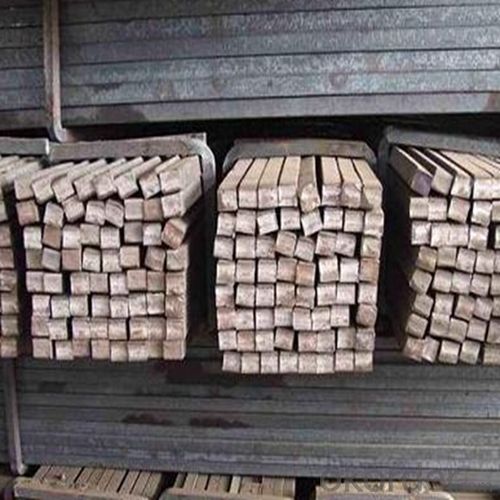
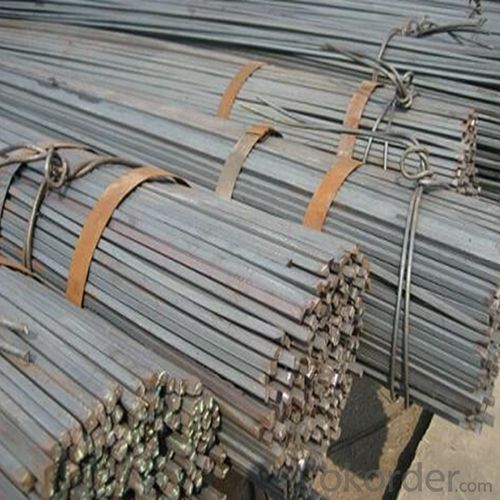

4. Steel Billet in Square Straight Form Big Sizes Specification:
Mechanical Properties | Grade | Steel diameter(mm) | |||
≤16 | 16~40 | 40~60 | 60~100 | ||
Yield Point Δs/MPa | Q195 | ≥195 | ≥185 | - | - |
Q235 | 235 | 225 | 215 | 205 | |
Tensile Strength | Q195 | 315~390 | |||
Q235 | 375~500 | ||||
Elongation δ5% | Q195 | ≥33 | ≥32 | - | - |
Q235 | 26 | 25 | 24 | 23 | |
5. FAQ
We have organized several common questions for our clients,may help you sincerely:
①What is the main material?
There are two types of Square Bar, one is hot rolled square bar and other one is cold drawn square bar. Our principal products is hot rolled square bar. We dedicate to products with material Q195 and Q235. We offer products with high quality and low price.
②How to inspect the quality?
We have a professional inspection group which belongs to our company. We resolutely put an end to unqualified products flowing into the market. At the same time, we will provide necessary follow-up service assurance.
③Is there any advantage about this kind of product?
Steel I beam bar IPE has a reduced capacity in the transverse direction, and is also inefficient in carrying torsion, for which hollow structural sections are often preferred.
- Q:How do you use a steel square to determine the angle of a miter cut?
- To determine the angle of a miter cut with a steel square, follow these steps: 1. Position the steel square against the material's edge, ensuring the long side aligns with the edge, at a 90-degree angle. 2. Use a pencil or marker to draw a line along the inside edge of the square, representing the 90-degree angle. 3. Adjust the steel square along the edge until the desired miter cut angle is achieved. For example, if you want a 45-degree miter cut, align one of the square's edges with the previously drawn line at the 90-degree angle. 4. Once the steel square is aligned for the desired angle, draw another line along the inside edge of the square, representing the miter cut angle. 5. Connect the starting point of the 90-degree line with the endpoint of the miter cut line using a straight edge or ruler. This will create an accurate cutting guide representing the miter cut angle. By employing a steel square in this manner, you can effortlessly determine and mark the precise angle for a miter cut, ensuring precise and accurate cuts in your woodworking or construction projects.
- Q:How do you use a steel square to determine the angle of a compound taper cut?
- To determine the angle of a compound taper cut using a steel square, you need to follow a few steps. First, place the steel square's long side against the edge of the material you want to cut. Next, align the square's short side with the desired direction of the taper cut. Then, measure the distance from the square's short side to the material's edge at both ends of the cut. Finally, calculate the difference between the two measurements and use a tangent table or calculator to find the corresponding angle.
- Q:How do you use a steel square to find the height of a wall?
- To use a steel square to find the height of a wall, you need to follow a few simple steps. First, position yourself at a distance from the wall that allows you to have a clear view of the entire height. Make sure you have enough space to maneuver the steel square comfortably. Hold the steel square in your dominant hand, with the shorter leg (also known as the tongue) pointing upward and the longer leg (also known as the blade) resting against the wall. Ensure that the square is perfectly vertical and aligned with the edge of the wall. Next, look at the markings on the blade of the steel square. These markings are usually in inches or centimeters and will help you determine the height of the wall. Starting from the bottom of the wall, locate the point where the blade aligns with the top of the wall. Once you have identified this point, mark it on the wall using a pencil or chalk. To get an accurate measurement, you may need to move closer or further away from the wall and adjust your position until you can clearly align the steel square with the top of the wall. Finally, measure the distance from the bottom of the wall to the marked point on the steel square using a tape measure or ruler. This measurement will give you the height of the wall. Remember to double-check your measurement and ensure that the steel square remains vertical throughout the process. Accuracy is essential to obtain an exact height measurement. Using a steel square to find the height of a wall is a simple and effective method that can be used in various construction or DIY projects.
- Q:Can a steel square be used for checking the squareness of a lathe tailstock?
- No, a steel square is not suitable for checking the squareness of a lathe tailstock. A precision square specifically designed for this purpose should be used to ensure accurate measurements and alignment.
- Q:How do you use a steel square to determine the angle of a compound bevel cut?
- To use a steel square to determine the angle of a compound bevel cut, follow these steps: 1. Position the steel square on the workpiece: Place the longer side of the square against the edge of the workpiece, ensuring that it is perpendicular to the surface. 2. Align the square with the bevel cut: Adjust the angle of the square so that it aligns with the bevel cut you want to determine the angle of. Make sure that the shorter side of the square is parallel to the bevel cut. 3. Measure the angle: Once the square is aligned with the bevel cut, look at the scale on the square. It will have markings indicating different angles. 4. Read the angle measurement: Determine the angle by reading the measurement where the longer side of the square intersects with the scale. This will give you the angle of the compound bevel cut. 5. Transfer the measurement: Once you have determined the angle, you can transfer this measurement to your cutting tool or machinery to accurately set the bevel angle and make the compound bevel cut. It is important to note that using a steel square to determine the angle of a compound bevel cut may require some practice and precision to ensure accurate measurements. Additionally, for more complex angles or precise cuts, it may be necessary to use specialized tools or consult a professional.
- Q:Can a steel square be used for checking the squareness of a cabinet door opening?
- Yes, a steel square can be used for checking the squareness of a cabinet door opening. A steel square is a tool commonly used in woodworking and construction to ensure that corners and edges are perfectly square. It consists of a long arm and a shorter arm that meet at a 90-degree angle. By placing the steel square against the corners of the cabinet door opening, you can determine if the angles are perfectly square or if adjustments need to be made. This is important in ensuring that the cabinet door will fit properly and function correctly once installed.
- Q:Can a steel square be used for chair rail installation?
- Certainly! Chair rail installation can indeed make use of a steel square. This tool, frequently employed in carpentry and woodworking endeavors, boasts remarkable versatility. It accurately measures and marks angles, lines, and lengths. Employing a steel square guarantees flawless cuts and angles for chair rail sections. Additionally, it aids in ascertaining the ideal height and positioning of the rail on the wall. While alternative tools exist for chair rail installation, the efficacy of a steel square remains unparalleled.
- Q:Can a steel square be used for measuring diagonals?
- No, a steel square cannot be used for measuring diagonals as it is specifically designed for measuring right angles and not diagonals.
- Q:How do you maintain and care for a steel square?
- To maintain and care for a steel square, it is important to keep it clean and free from rust. Regularly wipe it down with a dry cloth after use to remove any dirt or debris. To prevent rust, apply a thin layer of oil or rust inhibitor to the square, especially if it will be stored for an extended period. Avoid exposing the square to moisture or harsh environments. Additionally, store it in a dry place and protect it from any physical damage that may affect its accuracy.
- Q:How do you use a steel square to find roof pitch?
- To use a steel square to find roof pitch, you would first align the square's tongue along the bottom edge of the roof rafter. Then, rotate the square until the rafter's edge intersects with the square's pivot point. The measurement on the square's blade will indicate the roof pitch angle, allowing you to determine the slope or pitch of the roof.
1. Manufacturer Overview |
|
|---|---|
| Location | |
| Year Established | |
| Annual Output Value | |
| Main Markets | |
| Company Certifications | |
2. Manufacturer Certificates |
|
|---|---|
| a) Certification Name | |
| Range | |
| Reference | |
| Validity Period | |
3. Manufacturer Capability |
|
|---|---|
| a)Trade Capacity | |
| Nearest Port | |
| Export Percentage | |
| No.of Employees in Trade Department | |
| Language Spoken: | |
| b)Factory Information | |
| Factory Size: | |
| No. of Production Lines | |
| Contract Manufacturing | |
| Product Price Range | |
Send your message to us
Steel Billet in Square Straight Form Big Sizes
- Loading Port:
- Tianjin
- Payment Terms:
- TT OR LC
- Min Order Qty:
- 25 m.t.
- Supply Capability:
- 1000 m.t./month
OKorder Service Pledge
OKorder Financial Service
Similar products
New products
Hot products
Hot Searches
Related keywords
